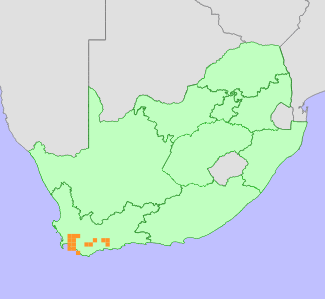|
Scientific Name | Cyclopia maculata (Andrews) Kies |
Higher Classification | Dicotyledons |
Family | FABACEAE |
Synonyms | Cyclopia laricina E.Mey., Cyclopia tenuifolia Lehm., Gompholobium maculatum Andrews |
Common Names | Naaldblaar-heuningbostee (a), Needle-leaf Honeybush Tea (e), Rooibossietee (a), Rooibostee (a), Rooitee (a), Vleitee (a) |
National Status |
Status and Criteria | Near Threatened B1ab(iii,v)+2ab(iii,v) |
Assessment Date | 2022/10/27 |
Assessor(s) | J.H. Vlok, D. Raimondo & N.N. Mhlongo |
Justification | This range-restricted species has an extent of occurrence (EOO) of 12 039 km² and an area of occupancy (AOO) of 192 km², known from at least 15 locations. The population is declining due to illegal harvesting and water abstraction, with its habitat being particularly susceptible to encroachment by invasive alien species. Therefore, it qualifies as Near Threatened under criterion B. |
Distribution |
Endemism | South African endemic |
Provincial distribution | Western Cape |
Range | This species is endemic to the Western Cape Province, where it is distributed from Bain's Kloof to Riversdale. |
Habitat and Ecology |
Major system | Terrestrial |
Major habitats | Boland Granite Fynbos |
Description | Plants grow on riverbanks and stream sides in lowland fynbos at altitudes between 150-830 m. |
Threats |
| Although known across a wide area from Bainskloof to Riversdale, much of this species' habitat, particularly stream sides and river courses, is severely infested with alien invasive plants (Acacia spp.) and is further impacted by water abstraction. About 14% of the habitat of this species has been transformed (calculated using GIS). Additionally, this species is harvested for the honeybush tea industry. As a reseeding species, it is vulnerable to overharvesting. Despite being part of a long-term trade in honeybush, the honeybush tea industry has gradually declined since 2012, with exported volumes dropping drastically from 300 tons to only 100 tons in 2021 (Gerrie Ferreira, pers. comm 2022). |
Population |
No population data are available for this species. However, the population is suspected to be in decline due to competition from invasive alien plants and unsustainable harvesting for the honey bush tea industry.
|
Population trend | Decreasing |
Assessment History |
Taxon assessed |
Status and Criteria |
Citation/Red List version | | Cyclopia maculata (Andrews) Kies | NT B1ab(iii,v) | Raimondo et al. (2009) | |
Bibliography |
Goldblatt, P. and Manning, J.C. 2000. Cape Plants: A conspectus of the Cape Flora of South Africa. Strelitzia 9. National Botanical Institute, Cape Town.
Raimondo, D., von Staden, L., Foden, W., Victor, J.E., Helme, N.A., Turner, R.C., Kamundi, D.A. and Manyama, P.A. 2009. Red List of South African Plants. Strelitzia 25. South African National Biodiversity Institute, Pretoria.
Schutte, A.L. 1997. Systematics of the genus Cyclopia Vent. (Fabaceae, Podalyrieae). Edinburgh Journal of Botany 54(2):125-170.
|
Citation |
| Vlok, J.H., Raimondo, D. & Mhlongo, N.N. 2022. Cyclopia maculata (Andrews) Kies. National Assessment: Red List of South African Plants version . Accessed on 2025/08/21 |
 Comment on this assessment
Comment on this assessment

